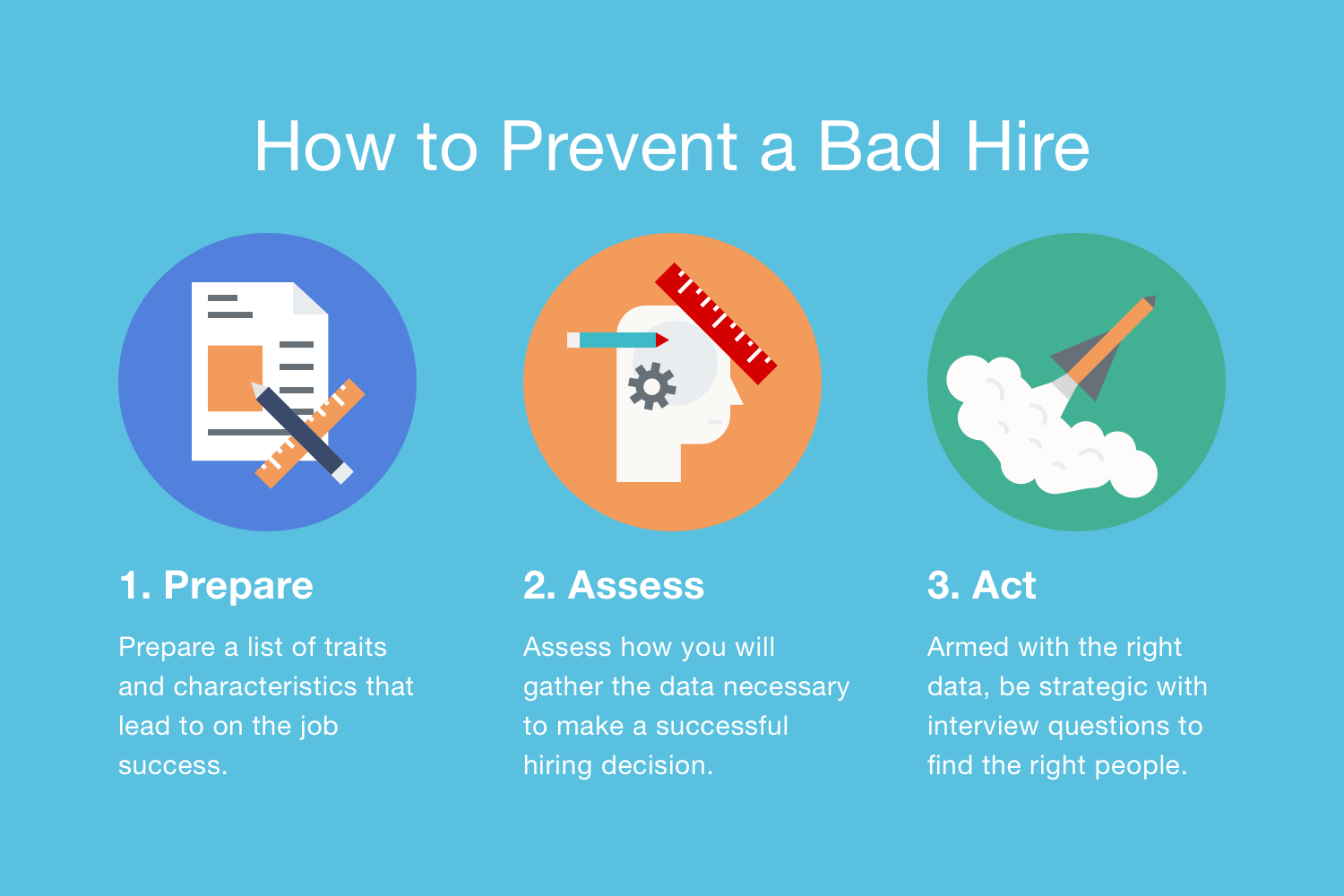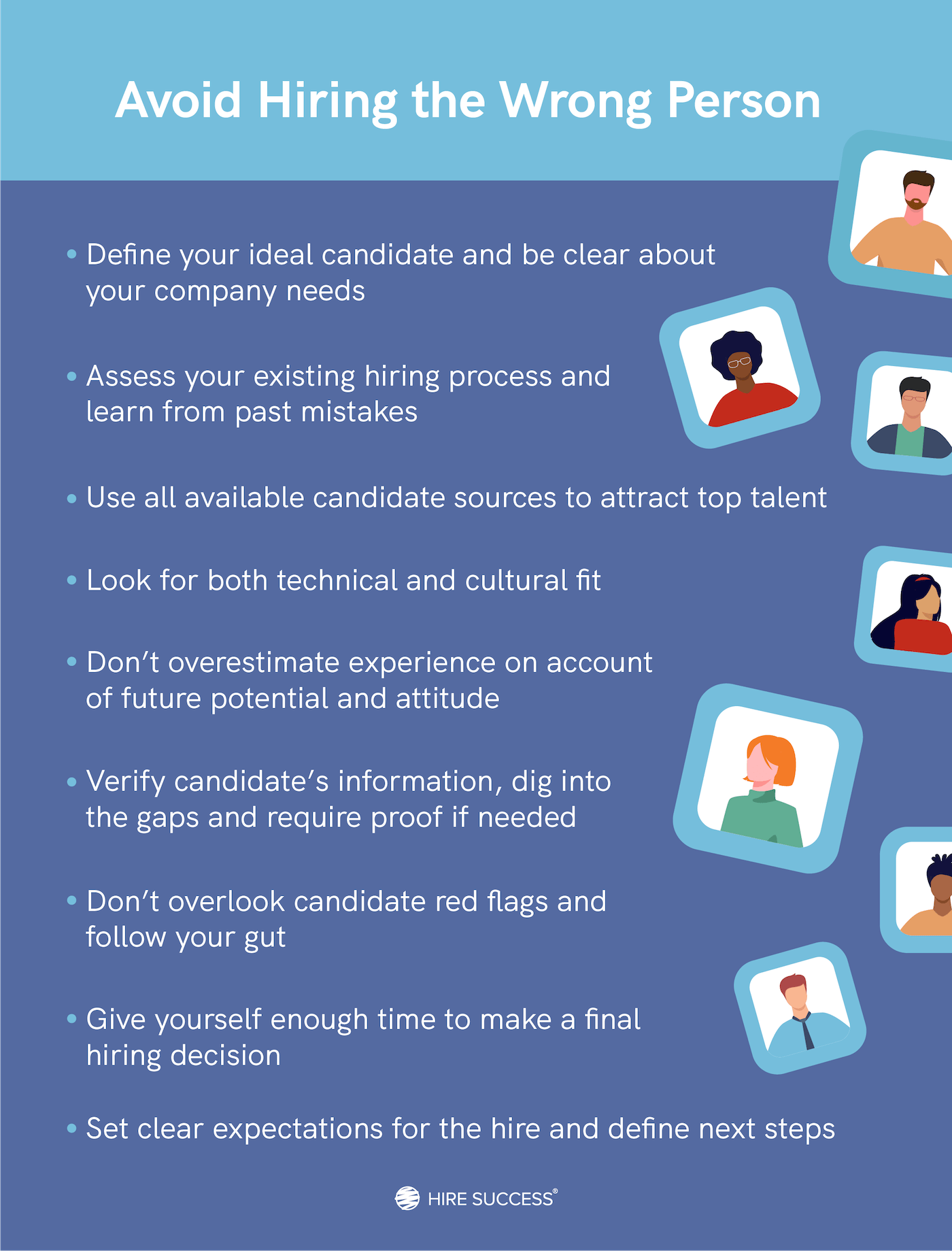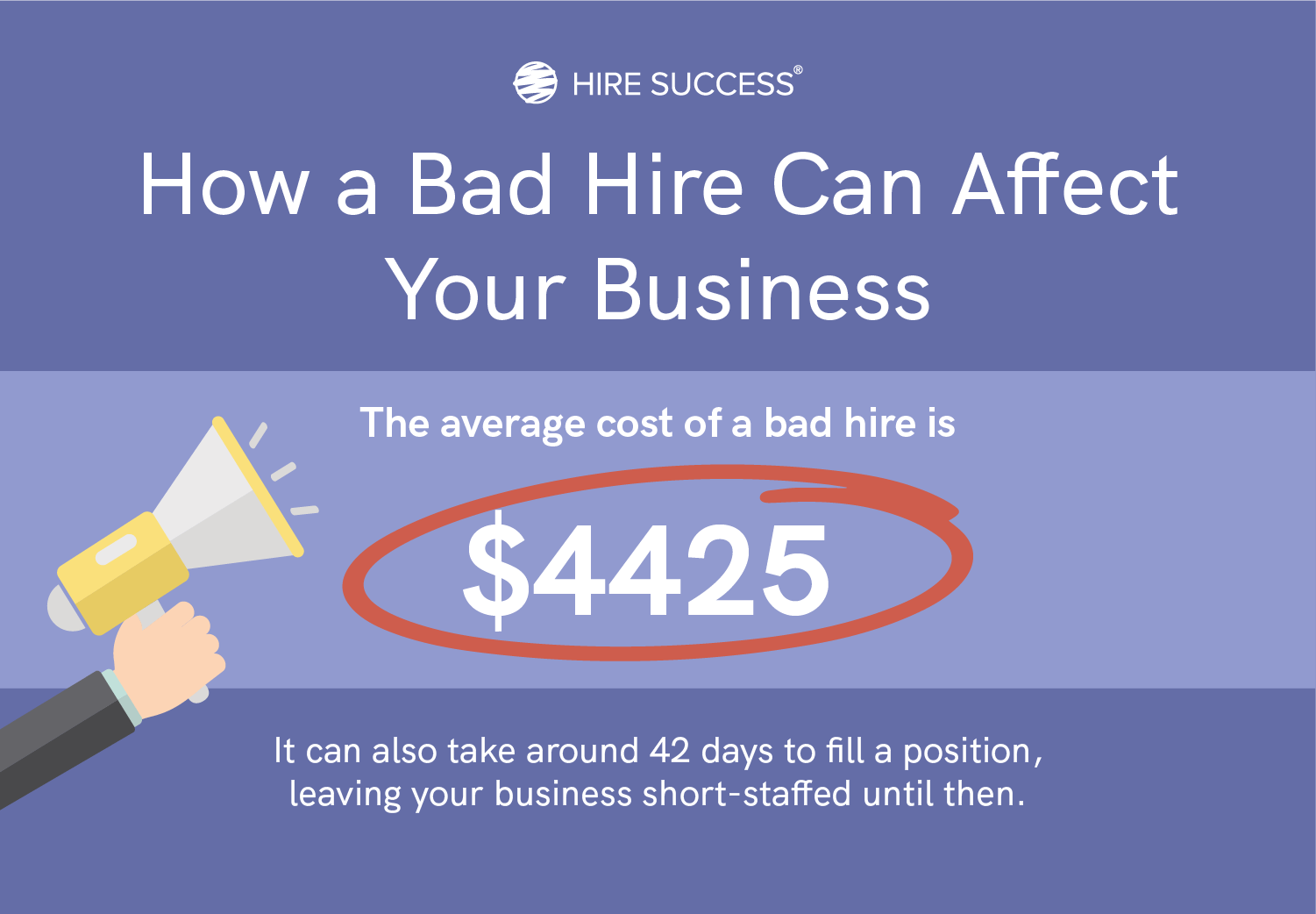Hiring the right people to fill your team is always a challenge, and it’s even harder today. But can you afford a bad hire? Hiring the wrong employee could be one of the worst things to ever happen to your company. The negative energy from one bad hire can impact your whole office space, sink your productivity, and even damage your business’s reputation.
To keep your team happy and bottom line healthy, you need to make avoiding bad hires a top priority.
Key takeaways
- Job seekers may exaggerate or lie on their applications, so it's crucial to verify the information they provide and address any gaps or omissions.
- The consequences of a bad hire often extend beyond financial losses, impacting team morale, productivity, and the overall success of your business.
- Personality and skills testing, along with thorough background checks, can help prevent bad hires by ensuring candidates are well-suited for the role and your company’s culture.
What is a bad hire?
A "bad hire" refers to a candidate who is selected for a position but, ultimately, turns out to be unsuitable for the role or the company. This can occur for a variety of reasons, but some of the most common ones include a lack of skills or undesirable personality traits. Employers can usually spot new employee red flags, but it’s important to know which ones to address and how to proceed next.
The full cost of hiring the wrong candidate can be significant. A bad hire can lower employee morale and actively cost your business money through their poor performance. Factor in the cost of recruiting, assessing candidates, interviewing, hiring, and onboarding new employees, and the whole experience can become both costly and time-consuming.
The ideal candidate for the job will be skilled, thorough, and able to get along with other members of your team. Still, how will you recognize that person? Can you prevent bad hires?

Fortunately, it’s easy for you and your company to prevent bad hires by following three steps:
- Prepare. Know what your ideal candidate should have in terms of skills, experience, personality, and attitude.
- Assess. Use research, diagnostic tests, and interview skills to determine if a candidate is a smart fit. Do background checks.
- Act. Quality talent is in high demand. Be prepared to make a competitive offer immediately when you find the right candidate.
By following these steps, you can find the perfect employee for any open position and set up your company for success. Let’s get started.
What are the most common reasons for bad hires?
Bad hires come in several forms. Some people exude the kind of toxic negativity that can ruin a team dynamic and bring everybody down. Others are pleasant but too incompetent to get the work done. Some might be able to do the work, but are unreachable. A number of candidates lack the confidence to make a decision or complete a task without oversight.
When you introduce a bad hire into a team setting, the negative impacts can include overall productivity loss, lower job satisfaction rates, and even reputational damage. How do bad hires worm their way in? Here are the most common reasons people make bad hiring decisions.
- Interviewer bias. A candidate shows up to an interview who seems perfect. The prospective employee fits your ideal image and similar interests. The interview goes well and you hire them. Unfortunately, they aren’t qualified for the position and your other employees resent having to pick up the slack.
- Badly defined job position needs. You haven’t properly defined the job needs and ideal candidate.
- Candidate misrepresentation. The candidate exaggerates their skills and abilities.
- Poor interview process. Your questions don’t reveal the candidate’s character.
- Not enough information about the candidate. You didn’t administer the tests that would identify the skills and character traits necessary for the job.
Move beyond resumes, identify true potential
Make smarter hiring decisions using objective data on candidates' strengths, work styles, and personality traits.
Book a Demo Try It Free9 ways to avoid hiring the wrong person
It’s easy and costly to make a mistake. Said Ray Dalio, founder of Bridgewater Associates: “Hire right, because the penalties of hiring wrong are huge.”
How can an employer avoid hiring the wrong person? Here are nine ways to avoid the penalties of hiring wrong.
1. Define your ideal candidate and be clear about your company needs
Identify what makes someone a top candidate for a particular job. Before you narrow down your list of job applicants or start holding interviews, it’s best to develop an effective job description and a list of characteristics desired in a potential employee. What might make a candidate a bad hire for your company? Will the right person be an introverted or extroverted worker? Do they see the big-picture or are they a detail-oriented person?
For inspiration, look at the people in your office who are successful in the same position. If you’re hiring for a sales position, take a look at the personality traits of your top salespeople. What do they have in common? Depending on your industry, your top salespeople may be confident, engaging, and energetic enough to sell cars or empathetic and soft-spoken enough to serve mourners. Defining specific personality traits for each role helps you weed out disruptive or jarring personalities.
If you’re hiring an employee to fill a new role, look at similar job descriptions online and see what other companies seek out. This can help you formulate your ideal employee hiring profile.
2. Assess your existing hiring process and learn from past mistakes
Hiring can be a waste of time. If you’re spending a lot of time interviewing people you would never hire, or worse, hiring the wrong people, your hiring process is the problem. You may be spending so much time trying to narrow down a large applicant pool using traditional criteria like experience and education that you miss the critical qualities.
With the ideal candidate in mind, Hire Success® can administer pre-employment personality tests and integrity tests to narrow the applicant pool down to likely candidates by learning attributes you cannot uncover with a resume.

3. Use all available candidate sources to attract top talent
Posting on a general job board can bring in plenty of applicants, but if you want to attract top talent, consider widening your search. Hiring recruiters is an effective way to lure employed candidates not actively looking for a new job.
To attract candidates with specialized skills, place ads on an industry-specific job board. You may also find great candidates by asking your top-performing employees in the same department to spread the word through social media.
Another often overlooked possibility is promoting from within. The stellar talent you need might be right under your nose. Promotion from within is great for your company image.
4. Look for both technical and cultural fit
You need to hire people with the right skillset, but in today’s marketplace, company culture has higher importance than ever before. Consumers want to do business with companies they can relate to and expect certain behavior and values from everyone associated with your company.
Make sure new employees have the right personality type, fit your company's image, and uphold your values. One employee carrying a swastika flag at a protest rally could undermine all the work you’ve done to build your brand. Personality testing can help you objectively assess cultural fit.
5. Don’t overestimate experience on account of future potential and attitude
While most employers value experience, this isn’t always a good predictor of future performance. Sadly, the number of years performing a job or the number of jobs a candidate has had do not indicate the quality of their work. Workers can easily be mediocre at their jobs for decades. Some of the more charming or connected personalities can even fail upwards.
Conversely, an employee with great potential may have been passed over or assigned to tasks well below their abilities and appear to be mediocre when they are not. A new hire with a great attitude and the aptitude for the job may be a much better hire than an experienced person with poor performance.
Say goodbye to guesswork, hire with confidence
Try our platform for free and get unbiased, data-driven insights into candidates' personal qualities and abilities.
Book a Demo Try It Free6. Verify candidate’s information, dig into the gaps and require proof if needed
Job seekers tend to lie and exaggerate their applications. During the interview process, it’s important to verify all the information you can and find out why there are gaps or omissions. While your job description may put a higher value on experience or knowledge over academics, you might want to know if a potential hire lied.
Candidates might also exaggerate their skills. That’s where Hire Success®' aptitude and skills tests come into play. Hire Success® can assess the true potential of your prospective hires.
7. Don’t overlook candidate red flags and follow your gut
In the rush to hire, interviewers often ignore red flags. Be aware of the signals candidates are sending and explore any concerns ahead of time. If you sense something isn’t right, trust your instincts. The following examples could be signs of a bad candidate:
- They don’t ask any questions. Lack of questions could indicate no interest, arrogance or fear that questions will reveal weakness.
- They avoid discussing any flaws. Refusing to acknowledge weaknesses could indicate lack of humility or self-awareness.
- They arrive late to the interview. While there are many legitimate reasons to be late, it may indicate disorganization.
- They are unprepared for the interview. A good candidate will understand the position, be qualified, and know at least the basics about the company.
- They don’t seem adaptable. If you mention additional job responsibilities and they object, they may never be able to adapt to change.
8. Give yourself enough time to make a final hiring decision
It’s more important to hire the right person than fill the seat. Given the cost of a bad hire and how devastating a toxic personality can be to your team, it’s better to take the time needed to attract, identify, vet, interview, and onboard the right new team member rather than settle for someone with the right technical skills.
Don’t forget to perform reference checks and background verification to avoid any unwanted surprises down the road.
9. Set clear expectations for the hire and define next steps
You can’t expect new employees to hit the ground running without instructions. During the hiring process, you should know their strengths and weaknesses. Before hiring is finalized, make sure they understand what the job entails and what comes next. Walk them through the onboarding and training process.
What happens when you hire the wrong person?
It might take some time to realize you’ve hired the wrong person, but you’ll eventually discover the employee isn’t the right fit. You might see mistakes on the job or personality conflicts with colleagues or clients. If the signs are subtle, you and your managers might be in denial. Who wants to admit they’ve chosen the wrong person and go through the hiring process again?
Some managers prefer to keep an underperforming employee to avoid the hassle of starting over the hiring process. However, keeping a bad hire ends up costing a lot more time and money than you may think.
How much can a bad employee cost you?
When you hire the wrong person for a job, it creates a ripple effect of inter-organizational problems.
Some of the most common problems are easily identifiable. For example, a dip in sales is often the trademark of a bad hire. Not all costs are easily measurable, though. A bad employee can affect the morale and productivity of your entire staff, upset loyal customers, and cause catastrophic indirect disruptions.
Here are some of the most common consequences and costs of having bad hiring strategies at your business:
1. Hiring costs

Zippia reports that the average cost per hire in 2021 was $4,425, with the median cost at $1,633. In other words, the more a position pays, the more hiring costs. In 2023, Jobera estimates the average cost to be even higher at $4,700. CFO cost far more to hire than officials in middle management. Either way, hiring a new employee is a major investment.
Depending on industry and location, the average time to fill a vacancy is between 36 and 42 days. That’s more than a month short-staffed, potentially affecting every aspect of the business.
Dealing with the fallout of a bad hire and then starting the whole hiring and training process over is both time consuming and expensive.
2. Low employee productivity
When an employee fails to meet job expectations, it affects the entire organization's goals.
One employee turning in poor performance could prevent your company from meeting sales or revenue goals or meeting project milestones. Low performing employees force others to pick up the slack. To meet departmental goals, they must spend time correcting errors or helping to get another employee’s work done.
This has a cascading failure effect, limiting the potential and productivity of the remaining team.
3. Wasted time spent recruiting and training
When you add the cost of hiring a new employee to the cost of training, it’s a considerable expense. The time spent training a newly hired employee is an investment in both the business and the person. The average new start takes 3 months to become fully productive.
A hire without training or experience might cost less financially, but will require a longer adjustment period. Some applicants might look great on paper, but have the personality of a wet napkin. If they don’t fit your team’s dynamic collaboration, they won’t get the job done.
Hiring is a two-way street. This is a job-seeker’s market. If they don’t like your company or don’t fit in with your team, they are quick to quit. There’s even a name for the record number of people leaving their jobs: the Great Resignation Wave.
Hiring and training a new person who ultimately doesn’t fit with your team, only for them to take those skills elsewhere is disappointing, frustrating and expensive. To prevent wasting time and money on a bad hire, it’s critical to know what hiring mistakes to avoid.
4. Low employee morale
Staff turnover has a detrimental effect on employee morale and recruitment. Every remaining team member has to pick up the slack, working extra hours to cover the extra workload. The negative impact can cause bad attitudes and resentment.
Equally, a bad fit with the existing team can detriment team spirit. A toxic work environment leads to increased sick leave and lowers overall productivity significantly.
High turnover can also affect the quality of prospective talent. With social media, news of a toxic work environment spreads quickly.
5. Damage to your company’s reputation
Having the wrong person in a role can affect your brand. Customers today have more ways than ever to spread the word about their experience and social media users aplenty love the shock value of a terrible service story. Online reviews can directly affect sales and a badly handled complaint can create nightmare headlines. It pays to avoid bad hires.
6. Lost prospects and customers
Negative reviews sparked by bad hires can be devastating. Poor customer service and unprofessional mistakes lead to lost revenue. Existing customers may cut ties rather than risk a repeat negative experience and new client prospects will go elsewhere instead.
In extreme circumstances, reputational damage could affect your vendor relationships and where you can advertise.
How to calculate the cost of a bad hire
The formula for calculating cost per hire is:
The value of all internal recruiting costs plus the value of all external recruiting costs, divided by the total number of hires for a specific period.
Typically, internal recruiting expenses include:
- Job advertisement fees
- Candidate assessment costs
- Recruitment branding
- Hiring manager’s salaries
- Employee benefits
- Travel expenses incurred while recruiting new employees
External recruiting costs include the contractual costs of a recruitment agency, external recruiter or staffing firm.
Taking into account employee turnover, costs range between 100% and 300% of the replaced employee’s salary, and that more than 20% of new hires will subsequently leave the post within 12 months. The cumulative cost of hiring the wrong person can be expensive.
What to do when you’ve made a bad hire
Finding the right person for the job isn’t easy, and having the wrong employee on your team — even briefly — is expensive. Unfortunately, a lot of businesses suffer from hiring the wrong person for the job.
You need to find people who are well-suited to their jobs. You need to find them the first time. Ideally, with the right team, you’ll build a working environment that encourages quality hires to stay with you for years.
Now, let’s talk about what to do should you make a bad hiring decision.
1. Apply focused feedback or reassignment
Focused feedback directs attention to the most important aspect of an employee’s areas for improvement. With extra training or a different job assignment, you may be able to save a disappointing hire.
If reassignment is possible, financial losses might be mitigated by not having to go through the hiring process again for that post. The investments already made into hiring and training the employee is not entirely wasted.
Employees don't always underperform as a result of poor hiring decisions. Trust your instincts. You hired this person for a reason. Additionally, shop within. Sometimes the best employees are already inside your organization.
2. Identify the current and future expense of keeping a bad hire
Poor sales, missed goals and deadlines are just a few examples of the cost of hiring the wrong person. Every missed sale, goal or deadline risks revenue loss and compounds further problems. Before losses add up to a significant problem, it’s wise to assess the situation before taking action. Your choices are to retrain, reassign, or cut your losses and a toxic hire.
3. Prepare an exit plan
When conducting interviews and making hiring decisions, choose a backup candidate or two in case your initial choice doesn’t work out. If you can identify a bad hire quickly and act decisively, having a second choice candidate already in mind makes sense.
4. Fire gracefully
If you have to fire a bad hire, it's going to be an uncomfortable conversation. The new employee knows his performance isn’t up to par, but may be defensive or even accusatory. The best way to handle the issue is kindly, but firmly. You may be surprised, the employee may have ideas about how they can improve or what training they need to get better results.
There are a few ways to soften the blow. Tell them how impressed you were with their interview and qualifications and explain that they were simply not a good fit for the team. Tell them that the job description calls for some other qualification. Ask them about their experience and invite input on how the team can improve. Treating an exiting employee with dignity is good for your brand image. Make it a positive interview and offer to provide a reference.
Of course, hiring the right person in the first place is the ideal situation, but things don’t always go as planned.
How Hire Success® can help limit your hiring expenses
Given the high cost of hiring the wrong person, it’s worth investing in the hiring process to avoid recruitment mistakes. Finding the right person the first time is a science and art.
Using scientifically-backed personality and aptitude tests, Hire Success® cuts down the cost of hiring by identifying candidates with preferred traits and skills.
Hire Success® then produces personalized questions for each candidate, helping you get to know your potential employee better in the limited interview time. This information identifies candidates who tick all the boxes and helps you get a better idea of which applicants will shine.


